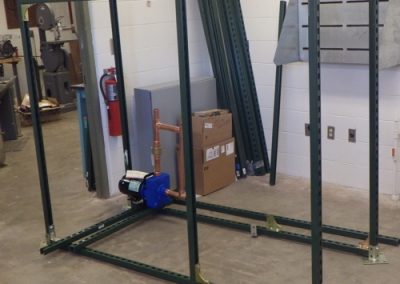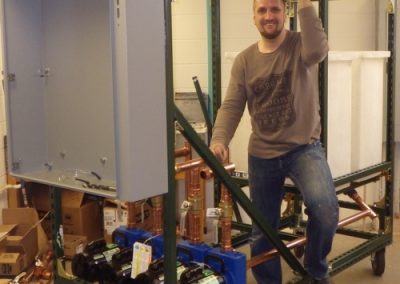Contact Us
UW Oshkosh
Department of Engineering & Engineering Technology
(920) 424-1547
engtech@uwosh.edu
Fax: (920) 424-1581
Pumping Station
Pumping stations are widely used in urban and industrial infrastructure. The most typical applications include following systems: (i) district water and sewage, (ii) storm water, (iii) heating, (iv) chilled water (buildings, industry), (v) power plants cooling and steam, and (vi) processed product in industrial sector (crude oil in refineries, pulp in paper industry, slurry in ethanol plants, milk products in diary plants, etc.).
According to the International Energy Agency, motors use 46% of all generated electricity. In the industrial sector this rate is higher and reaches 65%. 20% of power used in the manufacturing sector is consumed in pumping systems. In public utility sector, where pumps are used in a water/sewage/storm systems this rate can be even higher. These numbers in connection with the fact, that most of pumping systems, once designed and installed, have never been optimized, show the significance of possible improvements in this sector. Optimization of energy-intensive processes also perfectly fits one of the Grand Challenges for Engineering determined by the National Academy of Engineering: Restore and improve urban infrastructure.
All these reasons together gave an impulse to construct the experimental pumping station as a unique design in the UW Oshkosh Teaching and Energy Research Industrial Lab.
EXPERIMENTAL DESIGN
The system contains four centrifugal pumps AMT P63GSR-4977 (PU #1 – #4) installed in parallel configuration and set of armature with nominal diameter 1-1/2”. In the proposed pumping system, each pump can be controlled by three possible ways: (i) variable speed drive VSD #1 – #4 (Automation Direct GS2-21P0), (ii) throttling regulation valve Johnson Controls RV #1 – #4 (VG1241ES+906GGA), and the same type (iii) by-pass valve BV #1 – #4. Pumped water flows to a set of water tanks (68 liters each) through the load system composed of full port ball system (SV #1 – #4) and load valves (LV #1 – #4). After each pump in the experimental system full port ball characteristic valves (CV #1 – #4) were installed, which do not occur in typical systems. These valves can change pump characteristics for experimental purposes. The experimental unit has been additionally equipped with the following measurement devices: (i) electricity power meters ACUVIM II-D-60-5A-P1 (EM #1 – #4), (ii) suction pressure transducers OMEGA PX359-030A5V (PS #1 – #4), (iii) discharge pressure transducers IFM PX9114 (PD #1 – #4), and (iv) magnetic-inductive flow meters IFM SM9001 (FM #1 – #4). National Instrument analog input module NI 9205 converts all of measurements signals (4-20 mA or 1-5V) to digital form. In addition, the National Instrument Analog output module NI 9264 allows for control of automatic valves (RV #1 – #4) and variable speed drives (VSD #1 – #4). Both modules plugged into the National Instrument data acquisition chassis NI cDAQ-9174 allows for remote unit’s control. Such system configuration together with in-house developed program, based on the LabVIEW 2015 platform, allows for advanced control and data acquisition.
INTEGRATION WITH THE ENGINEERING TECHNOLOGY PROGRAM
The layout of the pumping station allows adoption for regular Engineering Technology courses, for example ET 318 Fluids II, ET 221 Machine Components, ET 320 Motors & Drives, ET 322 Design Problems, ET 390 Mechatronics, and ET 410 Capstone Project. In the future prospective it will also allow possible elective courses, for example: Advanced Measurement and Control Systems or Energy Management in the Industrial Sector. Besides regular classes, the experimental unit allows also for more advanced research in elaborating of an optimization method for a complex multi-pump system, installed in parallel configuration.
The presented pumping system has been constructed as a collaborative project with the UW Oshkosh ET students. Special thanks are directed to Stephen Hopfensperger (left), and Nelson Figueroa (center), who devoted their time and skills for the construction work of this pumping system, and to and Jamal Arafeh (right) who prepared technical documentation of the pumping system during his Undergraduate Independent Study project.
RESEARCH
Based on measurements performed on the pumping station, the journal-quality research manuscript, entitled “Genetic Optimization and Experimental Verification of Complex Parallel Pumping Station with Centrifugal Pumps” has been published.
The aim of this research is optimization analysis of a complex pumping system with set of parallel centrifugal pumps. Each pump in the station can be controlled by three different ways: (i) discharge valve, (ii) by-pass flow, and (iii) variable speed drive (VSD). How, the system should be managed to get the highest assessment rates in partially loaded flow conditions? For this purpose, three system’s estimation targets were defined: (i) minimization of power consumption, (ii) flow rate balancing and (iii) maximization of overall efficiency. These values are expressed as a function of control input parameters at each pump: (i) VSD frequency, (ii) discharge pressure after a pump and (iii) outlet flow rate conditioned by by-passed stream. To answer formulated question, genetic optimization analysis (GENOCOP) using uniquely developed numerical code (C++) has been performed for all of estimators.
Derived solutions proved existence of multiple local extrema for all of target functions. The specification of solutions indicated, that minimization of power consumption is the most reliable estimator out of all proposed. In addition, to bridge between research, development and implementation, all of modeling analyses were verified with measurements performed on real, experimental pumping station. Both results: genetic algorithm optimization and performed measurements confirmed each other. Besides general statements, conducted analyses provided more specific conclusions related to particular pumping station used in this research. Such conclusions can be very important for real engineering applications.

Department of Engineering and Engineering Technology















